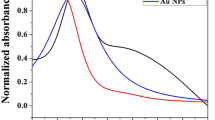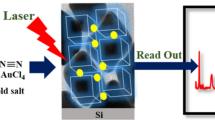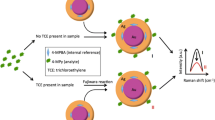Abstract
A surface-enhanced Raman scattering (SERS) method is described for the determination of trace polycyclic aromatic hydrocarbons (PAHs) in the environment efficiently and economically. Detection sensitivity is improved by modifying gold nanoparticles (AuNPs) with 4-mercaptophenylboronic acid (4-MPBA) conjugated to β-cyclodextrin (β-CD) as a new method for ratiometric determination of PAHs in solution. Pyrene (with a Raman band at 580 cm−1) and anthracene (750 cm−1) were used as the model analytes, while 4-MPBA (1570 cm−1) was used as the internal reference to normalize the SERS signals. The intensity ratios of pyrene/4-MPBA increase linearly in the 2 to 10 nM pyrene concentration range, and the intensity ratios of anthracene/4-MPBA increase linearly in the 10 to 100 nM anthracene concentration range. The detection limits are 0.4 nM for pyrene and 4.4 nM for anthracene. This method was applied to the determination of the two analytes in soil sample extracts and the recoveries of pyrene (at levels of 236 ng∙g−1 and 170 ng∙g−1) and anthracene (334 ng∙g−1 and 510 ng∙g−1) agreed well with the results from GC-MS analyses. The good recovery rates (101.8% and 102.5% for pyrene and 106.4% and 101.7% for anthracene) confirmed the reliability of the method.

Schematic illustration of SERS signal enhancement of pyrene, as an example of polycyclic aromatic hydrocarbons, by β-cyclodextrin modified gold nanoparticles.








Similar content being viewed by others
References
Laender De F, Hammer J, Hendriks AJ, Soetaert K, Janssen CR (2011) Combining monitoring data and modeling identifies PAHs as emerging contaminants in the Arctic. Environ Sci Technol 45:9024–9029. https://doi.org/10.1021/es202423f
Zhang Y, Tao S (2009) Global atmospheric emission inventory of polycyclic aromatic hydrocarbons (PAHs) for 2004. Atmos Environ 43:812–819. https://doi.org/10.1016/j.atmosenv.2008.10.050
Rascón AJ, Azzouz A, Ballesteros E (2018) Multiresidue determination of polycyclic aromatic hydrocarbons in edible oils by liquid-liquid extraction–solid-phase extraction–gas chromatography–mass spectrometry. Food Control 94:268–275. https://doi.org/10.1016/j.foodcont.2018.07.015
Armstrong B, Hutchinson E, Unwin J, Fletcher T (2004) Lung cancer risk after exposure to polycyclic aromatic hydrocarbons: a review and meta-analysis. Environ Health Perspect 112:970–978. https://doi.org/10.1289/ehp.6895
Beyer J, Jonsson G, Porte C, Krahn MM, Ariese F (2010) Analytical methods for determining metabolites of polycyclic aromatic hydrocarbon (PAH) pollutants in fish bile: a review. Environ Toxicol Pharmacol 30:224–244. https://doi.org/10.1016/j.etap.2010.08.004
Diamante G, do Amaral e Silva Müller G, Menjivar-Cervantes N, Xu EG, Volz DC, Dias Bainy AC, Schlenk D (2017) Developmental toxicity of hydroxylated chrysene metabolites in zebrafish embryos. Aquat Toxicol 189:77–86. https://doi.org/10.1016/j.aquatox.2017.05.013
Waterman D, Horsfield B, Leistner F, Hall K, Smith S (2000) Quantification of polycyclic aromatic hydrocarbons in the NIST standard reference material (SRM1649A) urban dust using thermal desorption GC/MS. Anal Chem 72:3563–3567. https://doi.org/10.1021/ac991372x
De Nicola F, Concha Graña E, Aboal JR, Carballeira A, Fernandez JA, López Mahía P, Prada Rodríguez D, Muniategui Lorenzo S (2016) PAH detection in Quercus robur leaves and Pinus pinaster needles: a fast method for biomonitoring purpose. Talanta 153:130–137. https://doi.org/10.1016/j.talanta.2016.01.067
Poster DL, Schantz MM, Sander LC, Wise SA (2006) Analysis of polycyclic aromatic hydrocarbons (PAHs) in environmental samples: a critical review of gas chromatographic (GC) methods. Anal Bioanal Chem 386:859–881. https://doi.org/10.1007/s00216-006-0771-0
Taghvaee Z, Piravivanak Z, Rezaei K, Faraji M (2016) Determination of polycyclic aromatic hydrocarbons (PAHs) in olive and refined pomace olive oils with modified low temperature and ultrasound-assisted liquid–liquid extraction method followed by the HPLC/FLD. Food Anal Methods 9:1220–1227. https://doi.org/10.1007/s12161-015-0297-1
Gutiérrez-Valencia TM, García de Llasera MP (2017) On-line MSPD-SPE-HPLC/FLD analysis of polycyclic aromatic hydrocarbons in bovine tissues. Food Chem 223:82–88. https://doi.org/10.1016/j.foodchem.2016.11.099
Schmidt H, Ha NB, Pfannkuche J, Amann H, Kronfeldt HD, Kowalewska G (2004) Detection of PAHs in seawater using surface-enhanced Raman scattering (SERS). Mar Pollut Bull 49:229–234. https://doi.org/10.1016/j.marpolbul.2004.02.011
Halvorson RA, Vikesland PJ (2010) Surface-enhanced Raman spectroscopy ( SERS ) for environmental analyses. Environ Sci Technol 44:7749–7755. https://doi.org/10.1021/es101228z
Campion A, Kambhampati P (1988) Surface-enhanced raman scattering. Chem Soc Rev 27:241–250. https://doi.org/10.1063/1.2812122
Tang S, Li Y, Huang H, Li P, Guo Z, Luo Q, Wang Z, Chu PK, Li J, Yu XF (2017) Efficient enrichment and self-assembly of hybrid nanoparticles into removable and magnetic SERS substrates for sensitive detection of environmental pollutants. ACS Appl Mater Interfaces 9:7472–7480. https://doi.org/10.1021/acsami.6b16141
Patze S, Huebner U, Liebold F, Weber K, Cialla-May D, Popp J (2017) SERS as an analytical tool in environmental science: the detection of sulfamethoxazole in the nanomolar range by applying a microfluidic cartridge setup. Anal Chim Acta 949:1–7. https://doi.org/10.1016/j.aca.2016.10.009
Zhang M, Zhang X, Shi Y, Liu Z, Zhan J (2016) Surface enhanced Raman spectroscopy hyphenated with surface microextraction for in-situ detection of polycyclic aromatic hydrocarbons on food contact materials. Talanta 158:322–329. https://doi.org/10.1016/j.talanta.2016.05.069
Zhong LB, Liu Q, Wu P, Niu QF, Zhang H, Zheng YM (2018) Facile on-site aqueous pollutant monitoring using a flexible, ultralight, and robust surface-enhanced Raman spectroscopy substrate: interface self-assembly of Au@Ag nanocubes on a polyvinyl chloride template. Environ Sci Technol 52:5812–5820. https://doi.org/10.1021/acs.est.7b04327
Sun H, Liu H, Wu Y (2017) A green, reusable SERS film with high sensitivity for in-situ detection of thiram in apple juice. Appl Surf Sci 416:704–709. https://doi.org/10.1016/j.apsusc.2017.04.159
Du J, Jing C (2011) Preparation of thiol modified Fe3O4@Ag magnetic SERS probe for PAHs detection and identification. J Phys Chem C 115:17829–17835. https://doi.org/10.1021/jp203181c
Zengin A, Tamer U, Caykara T (2018) SERS detection of polyaromatic hydrocarbons on a β-cyclodextrin containing polymer brush. J Raman Spectrosc 49:452–461. https://doi.org/10.1002/jrs.5300
Yildiz HB, Tel-Vered R, Willner I (2008) CdS nanoparticles/β-cyclodextrin-functionalized electrodes for enhanced photoelectrochemistry. Angew Chem Int Ed 47:6629–6633. https://doi.org/10.1002/anie.200801141
Yu Z, Smith ME, Zhang J, Yan J, Zhang P (2018) Determination of trichloroethylene by using self-referenced SERS and gold-core / silver-shell nanoparticles. Microchim Acta 185:330–336. https://doi.org/10.1007/s00604-018-2870-y
Frens G (1973) Controlled nucleation for the regulation of the particle size in monodisperse gold suspensions. Nat Phys Sci 241:20–22. https://doi.org/10.1038/physci241020a0
Zhou Y, Ding R, Joshi P, Zhang P (2015) Quantitative surface-enhanced Raman measurements with embedded internal reference. Anal Chim Acta 874:49–53. https://doi.org/10.1016/j.aca.2015.03.016
Yang S, Dai X, Stogin BB, Wong TS (2016) Ultrasensitive surface-enhanced Raman scattering detection in common fluids. Proc Natl Acad Sci 113:268–273. https://doi.org/10.1073/pnas.1518980113
Wang Y, Zhang J, Ding Y, Zhou J, Ni L, Sun C (2009) Quantitative determination of 16 polycyclic aromatic hydrocarbons in soil samples using solid-phase microextraction. J Sep Sci 32:3951–3957. https://doi.org/10.1002/jssc.200900420
Sun F, Littlejohn D, Gibson MD (1998) Ultrasonication extraction and solid phase extraction clean-up for determination of US EPA 16 priority pollutant polycyclic aromatic hydrocarbons in soils by reversed-phase liquid chromatography with ultraviolet absorption detection. Anal Chim Acta 364:1–11. https://doi.org/10.1016/S0003-2670(98)00186-X
Parlak C, Ramasami P, Tursun M, Rhyman L, Kaya MF, Atar N, Alver Ö, Senyel SM (2015) 4-Mercaptophenylboronic acid : conformation, FT-IR, Raman, OH stretching and theoretical studies. Spectrochim Acta A Mol Biomol Spectrosc 144:131–138. https://doi.org/10.1016/j.saa.2015.02.040
Du J, Xu J, Sun Z, Jing C (2016) Au nanoparticles grafted on Fe3O4 as effective SERS substrates for label-free detection of the 16 EPA priority polycyclic aromatic hydrocarbons. Anal Chim Acta 915:81–89. https://doi.org/10.1016/j.aca.2016.02.009
Santra S, Zhang P, Tan W (1999) The restoration of pyrene fluorescence of a Cu(II)–β-cyclodextrin–pyrene. Chem Commun 0:1301–1302. https://doi.org/10.1039/A903244D
Xie Y, Wang X, Han X, Song W, Ruan W, Liu J, Zhao B, Ozaki Y (2011) Selective SERS detection of each polycyclic aromatic hydrocarbon (PAH) in a mixture of five kinds of PAHs. J Raman Spectrosc 42:945–950. https://doi.org/10.1002/jrs.2818
Gu HX, Hu K, Li DW, Long YT (2016) SERS detection of polycyclic aromatic hydrocarbons using a bare gold nanoparticles coupled film system. Analyst 141:4359–4365. https://doi.org/10.1039/c6an00319b
Jiang M, Qian Z, Zhou X, Xin X, Wu J, Chen C, Zhang G, Xu G, Cheng Y (2014) CTAB micelles assisted rGO-AgNP hybrids for SERS detection of polycyclic aromatic hydrocarbons. Phys Chem Chem Phys 17:21158–21163. https://doi.org/10.1039/c4cp04888a
Chen J, Huang YW, Zhao Y (2015) Detection of polycyclic aromatic hydrocarbons from cooking oil using ultra-thin layer chromatography and surface enhanced Raman spectroscopy. J Mater Chem B 3:1898–1906. https://doi.org/10.1039/c4tb01632g
Latif U, Ping L, Dickert FL (2018) Conductometric sensor for pah detection with molecularly imprinted polymer as recognition layer. Sensors 18:767–775. https://doi.org/10.3390/s18030767
Acknowledgements
Support from the Center for Environmental Genetics (CEG) of the University of Cincinnati (NIH/NIEHS grant number P30ES006096) is greatly appreciated. Z. Y. would acknowledge the Doctoral Enhancement Award from the Chemistry Department, University of Cincinnati.
Author information
Authors and Affiliations
Corresponding author
Ethics declarations
The author(s) declare that they have no competing interests.
Additional information
Publisher’s note
Springer Nature remains neutral with regard to jurisdictional claims in published maps and institutional affiliations.
Electronic supplementary material
ESM 1
(DOCX 393 kb)
Rights and permissions
About this article
Cite this article
Yu, Z., Grasso, M.F., Sorensen, H.H. et al. Ratiometric SERS detection of polycyclic aromatic hydrocarbons assisted by β-cyclodextrin-modified gold nanoparticles. Microchim Acta 186, 391 (2019). https://doi.org/10.1007/s00604-019-3511-9
Received:
Accepted:
Published:
DOI: https://doi.org/10.1007/s00604-019-3511-9




